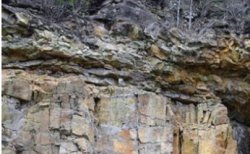
|
Instances of the Great Unconformity are being discovered all across North America. The phenomenon known as the Great Unconformity is a major gap in the continental geological record. Generally, rock layers are either in active geological areas where new layers of rock are added regularly, or in 'dead zones' such as the Canadian Shield, where old rocks remain on the surface. So it is puzzling to find places where very old rocks - in some cases more than 3 billion years old - were overlaid some 550 million years ago, after apparently being on the surface to 2.5 billion years without any new layers of rock covering them until then. In short the Great Unconformity is a major gap in the geological record, with nothing separating Precambrian basement rocks from much later Phanerozoic sedimentary rocks. |
|
|
In the last few years geologists have been better able to work out what happened because they can now study the age of these rocks with much greater precision using a dating technique called thermochronology. This method is based on analysis of helium in small grains of zircon. Helium atoms are formed at a constant rate from the radioactive decay of the elements uranium and thorium. Because zircons always contain traces of uranium and thorium, they are extremely useful for radiometric dating. In hot environments like those deep within the Earth, zircon crystals steadily lose helium atoms. But if the rock rises and cools it passes a certain temperature threshold, and the crystal lattice of the zircon cools enough to trap the helium inside. By quantifying the amount of uranium, thorium and helium in zircon, researchers can find the exact time when the helium was locked inside the zircon. This gives the age of the rocks and the precise time when the rocks started to lift and cool. In the United States, the Ozark Plateau has a region called the St. Francois Mountains which offer a very clear example of the Great Unconformity. In this area 1.4-billion-year-old granite and rhyolite lie directly underneath sandstone which is three times younger at 500 million years old. In another, more recent study of a granite outcrop from Pikes Peak in Colorado near the mountain town of Manitou Springs researchers found young rocks of less than 510 million years old overlying basement rocks dating back about 1 billion years. In both cases there were no rocks of intermediate age between. Thus the Great Unconformity (GU) is one of geology’s deepest mysteries and there is currently no widely accepted explanation. The leading theory is that there was once an intermediate layer of soft stone - e.g. sandstone - which endured very extensive denudation, until that layer was scraped away by moving water, by ice, by wind and by waves. Thus studies of rocks in the Ozark Plateau suggest that the mountains uplifted and cooled between 850 and 680 million years ago. This global tectonic uplift coincided with the breakup of the ancient supercontinent known as Rodinia. According to geologist Stephen Marshak and his colleagues the GU formations seen in Ozark Plateau triggered the so-called snowball Earth glaciations which began about 720 million years ago when much of the planet probably became covered in glacial ice which erased much of the geological footprint across the globe. But researchers working at the Pikes Peak site have a different theory. According to their thermochronological results most of the weathering happened before 'Snowball Earth'. Scientist Rebecca Flowers and her team believe that the Great Unconformity might not have been so great in the first place. As Rodinia crashed together then pulled apart over hundreds of millions of years, all that geologic activity may have caused many separate cases of extensive erosion around the world - making the Great Unconformity not just one megaevent but a series of smaller events. So is the Great Unconformity unique in the geological history of our planet? At the moment it seems so, since the uplift caused by the coming together and subsequent break-up of the world-continent Pangea did not result in anything similar to the GU or to glaciations akin to the snowball Earth event. Journal Reference:
| |
| _______________________________ | ||||
| Home | | | Shopping | | | Database |
© Biscuit Software 2004-2019
All rights reserved